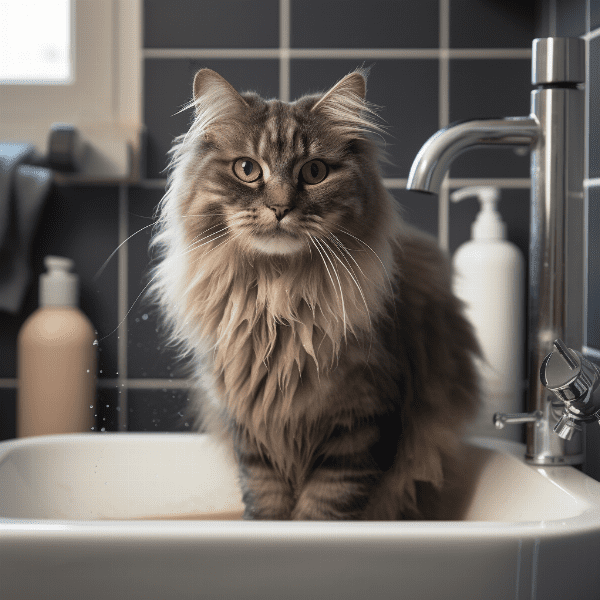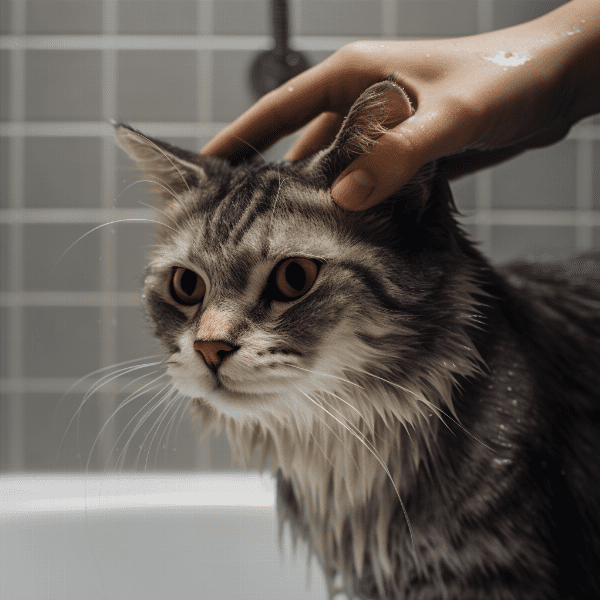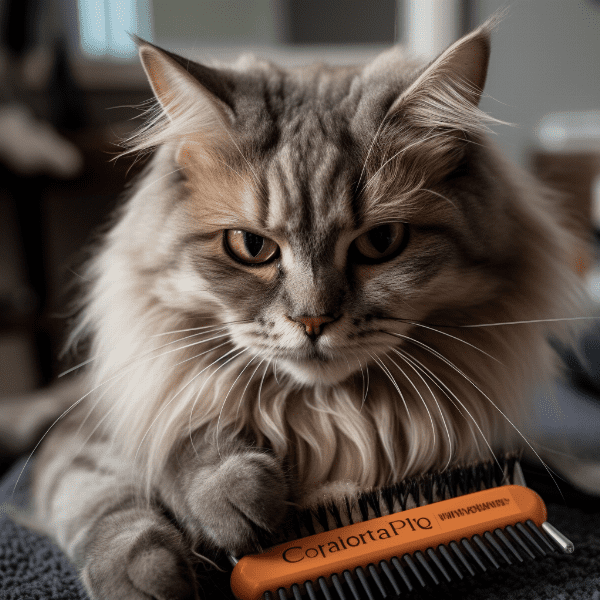Table of Contents
- Understanding Your Cat’s Bathing Needs
- Factors to Consider When Deciding How Often to Bathe Your Cat
- Signs Your Cat Needs a Bath
- How to Bathe Your Cat: Step-by-Step Guide
- Tips for Making Bath Time Easier for You and Your Cat
- Alternatives to Bathing Your Cat: Dry Shampoo, Wipes, and More
- Cat Grooming: Beyond Bathing
- Conclusion: Finding the Right Bathing Schedule for Your Cat
- Additional Resources for Cat Owners.
Understanding Your Cat’s Bathing Needs
If you’re a cat owner, you may have heard that cats are self-cleaning animals that don’t require frequent bathing. While it’s true that cats are adept at grooming themselves, there are still situations where a bath may be necessary.
The Importance of Your Cat’s Skin and Coat
Cats have delicate skin that requires special care. Their skin has a natural protective barrier that helps keep moisture in and irritants out. Bathing your cat too frequently can strip away this natural barrier, leaving their skin dry and vulnerable.
A cat’s coat is also an essential part of their overall health. A healthy coat helps regulate body temperature, protects the skin from damage, and helps your cat look and feel their best.
Factors That Affect How Often You Should Bathe Your Cat
There is no one-size-fits-all answer to how often you should bathe your cat. Several factors can influence how often your cat needs a bath, including:
- Coat length and type: Cats with long hair or thick coats may need more frequent baths than cats with short hair or fine fur.
- Age: Kittens and senior cats may need more help with grooming and bathing than adult cats.
- Health conditions: Cats with skin allergies, flea infestations, or other health conditions may require more frequent baths to alleviate symptoms.
- Lifestyle: Indoor cats that don’t spend much time outside may not need to be bathed as often as outdoor cats that get into dirt and other messes.
The Benefits of Regular Grooming
While bathing is an important part of cat grooming, it’s not the only thing you can do to keep your cat’s skin and coat healthy. Regular grooming can help remove loose hair, prevent matting, and distribute natural oils throughout your cat’s coat.
Brushing your cat’s fur regularly can also help prevent hairballs, a common problem in cats that can cause digestive issues and other health problems.

Factors to Consider When Deciding How Often to Bathe Your Cat
While there is no universal answer to how often you should bathe your cat, several factors can help you determine the best schedule for your feline friend.
Coat Length and Type
One of the primary factors to consider when deciding how often to bathe your cat is their coat length and type. Cats with long hair or thick coats may need more frequent bathing than cats with short hair or fine fur. Long-haired cats are more prone to matting and tangles, which can be difficult to remove without a bath.
Cats with thick fur may also be more likely to develop skin irritations or infections if dirt and debris get trapped in their coat. In contrast, cats with short hair may not need to be bathed as often, as their coats are easier to maintain.
Health Conditions
If your cat has a health condition that affects their skin or coat, they may need more frequent baths to manage symptoms. For example, cats with skin allergies may require regular baths with medicated shampoo to reduce itching and inflammation.
Cats with flea infestations may also need frequent baths to help remove fleas and their eggs from their fur. However, it’s important to note that over-bathing your cat can cause their skin to become dry and irritated, which can worsen symptoms.
Lifestyle
Your cat’s lifestyle can also play a role in how often they need a bath. Indoor cats that don’t spend much time outside may not need to be bathed as often as outdoor cats that get into dirt, mud, and other messes. Cats that spend time in a multi-cat household may also need more frequent baths to reduce the risk of spreading illnesses.
Your Cat’s Bathing Preferences
While cats are known for their fastidious grooming habits, not all cats enjoy getting wet. Some cats may become stressed or anxious during bath time, which can make the experience unpleasant for both you and your cat. If your cat resists bathing, you may need to adjust your bathing schedule or consider alternative grooming methods.
By considering these factors and observing your cat’s behavior and grooming habits, you can develop a bathing schedule that meets your cat’s unique needs and preferences.

Signs Your Cat Needs a Bath
While cats are typically fastidious groomers, there may be times when a bath is necessary to keep your feline friend clean and healthy. Here are some signs that your cat may need a bath:
Greasy or Matted Fur
If your cat’s fur appears greasy or matted, it may be a sign that they need a bath. Greasy fur can be caused by a buildup of natural oils, while matting can occur if your cat’s fur becomes tangled or knotted. A bath can help remove dirt and debris from your cat’s fur and restore its natural texture.
Unpleasant Odors
If your cat has an unpleasant odor, it may be time for a bath. Cats can develop odors for several reasons, including a buildup of bacteria on their skin or fur, urine or fecal matter trapped in their fur, or a skin infection. A bath with a gentle, cat-friendly shampoo can help eliminate odors and keep your cat smelling fresh.
Flea Infestations
If your cat has a flea infestation, a bath may be necessary to remove fleas and their eggs from their fur. While a bath alone may not eliminate a flea problem entirely, it can be an effective part of a comprehensive flea control plan.
Skin Irritations
If your cat has skin irritations, such as redness, itching, or flaking, a bath with a medicated shampoo may be necessary to soothe their skin and reduce inflammation. However, it’s important to consult with your veterinarian before using any medicated shampoos on your cat, as some products may be too harsh or irritating for certain cats.
Outdoor Adventures
If your cat spends time outdoors, they may be exposed to dirt, mud, and other debris that can get trapped in their fur. A bath may be necessary to remove these substances and keep your cat’s fur clean and healthy.
By paying attention to these signs and taking proactive steps to keep your cat clean and healthy, you can help ensure that your feline friend stays comfortable and happy.

How to Bathe Your Cat: Step-by-Step Guide
Bathing a cat can be a daunting task, especially if your feline friend is not accustomed to water. However, with a little patience and preparation, you can make bath time a positive and stress-free experience for both you and your cat. Here’s a step-by-step guide on how to bathe your cat:
Step 1: Gather Your Supplies
Before you begin, gather all the supplies you’ll need for the bath. This includes a cat-friendly shampoo, several towels, a washcloth, a cup or pitcher for rinsing, and a rubber mat or towel to provide traction in the tub or sink.
Step 2: Brush Your Cat’s Fur
Before getting your cat wet, brush their fur thoroughly to remove any tangles, mats, or loose hair. This will make the bathing process easier and more comfortable for your cat.
Step 3: Fill the Tub or Sink
Fill the tub or sink with a few inches of warm (not hot) water. The water level should be shallow enough to keep your cat’s head above water.
Step 4: Wet Your Cat’s Fur
Using a cup or pitcher, wet your cat’s fur thoroughly. Be careful not to get water in your cat’s ears or eyes.
Step 5: Apply Shampoo
Apply a small amount of cat-friendly shampoo to your cat’s fur, starting at the neck and working your way down. Avoid getting shampoo on your cat’s face, ears, and eyes.
Step 6: Massage and Rinse
Gently massage the shampoo into your cat’s fur, using a washcloth if necessary to clean hard-to-reach areas. Rinse your cat’s fur thoroughly with clean water, using a cup or pitcher.
Step 7: Dry Your Cat
Wrap your cat in a towel and gently pat them dry. If your cat allows it, you can use a hairdryer on the lowest setting to speed up the drying process. Be sure to keep the dryer several inches away from your cat’s fur to prevent overheating or burning.
Step 8: Reward Your Cat
After the bath, reward your cat with treats and praise to help reinforce positive associations with bath time.

Tips for Making Bath Time Easier for You and Your Cat
Bathing a cat can be a challenging experience, but there are several tips and tricks you can use to make bath time easier and more comfortable for both you and your feline friend.
Start Slow
If your cat is not used to water, it’s important to introduce them to the bathtub or sink slowly. Start by letting your cat explore the bathroom while the tub or sink is empty. Gradually add water to the tub or sink over several days, allowing your cat to get used to the sensation of water.
Use a Calming Agent
There are several natural products available that can help calm your cat during bath time. These include pheromone sprays, which mimic the scent of a cat’s natural calming pheromones, and herbal remedies, such as chamomile or lavender, which can help promote relaxation.
Keep Your Cat Calm
To keep your cat calm during the bath, speak to them in a soothing tone and offer gentle reassurance. Avoid using force or holding your cat down, as this can cause them to become more anxious and stressed.
Protect Your Cat’s Ears and Eyes
To prevent water from getting in your cat’s ears and eyes, place a cotton ball in each ear and use a washcloth to wipe their face. You can also use a special pet shampoo that is designed to be tear-free and gentle on your cat’s eyes.
Use Positive Reinforcement
Reward your cat with treats and praise after the bath to help reinforce positive associations with bath time. This will make your cat more likely to cooperate during future baths.
Make it a Routine
Establishing a routine for bath time can help make the process easier for both you and your cat. Try to bathe your cat at the same time each week, and follow a consistent sequence of steps to help your cat feel more comfortable and secure.
By following these tips and taking care to make bath time a positive and stress-free experience, you can help keep your cat’s fur clean and healthy while strengthening your bond with your feline friend.

Alternatives to Bathing Your Cat: Dry Shampoo, Wipes, and More
If your cat is not a fan of water or bathing, there are several alternative grooming methods you can use to keep their fur clean and healthy. Here are some options to consider:
Dry Shampoo
Dry shampoo is a powder or spray that can be applied to your cat’s fur to help absorb oil and remove dirt and debris. To use dry shampoo, sprinkle a small amount onto your cat’s fur and massage it in with your hands or a soft brush. Then, use a towel or brush to remove any excess powder.
Waterless Shampoo
Waterless shampoo is a foam or spray that can be applied to your cat’s fur and then wiped off with a towel or cloth. Waterless shampoo is formulated to clean and deodorize your cat’s fur without the need for water.
Cat Wipes
Cat wipes are pre-moistened wipes that are designed to clean and freshen your cat’s fur. They are especially useful for spot-cleaning your cat’s face or paws, or for giving your cat a quick refresh between baths.
Brushing
Regular brushing is an essential part of cat grooming, as it helps remove loose hair, prevent matting, and distribute natural oils throughout your cat’s coat. Brushing your cat’s fur daily can also help reduce the need for frequent baths.
Professional Grooming
If you’re not comfortable grooming your cat at home, you can take them to a professional groomer. A professional groomer can provide a variety of grooming services, including bathing, trimming, and nail clipping, to keep your cat looking and feeling their best.
By considering these alternative grooming methods and finding the one that works best for your cat, you can help keep your cat’s fur clean and healthy without the stress of traditional bathing.

Cat Grooming: Beyond Bathing
While bathing is an essential part of cat grooming, there are several other grooming tasks that can help keep your feline friend looking and feeling their best. Here are some other grooming tasks to consider:
Brushing
As mentioned earlier, regular brushing is an important part of cat grooming. Brushing your cat’s fur not only helps keep their coat healthy and shiny, but it also helps reduce shedding and prevent hairballs. Different types of brushes are available for cats with different coat lengths and types.
Nail Trimming
Regular nail trimming is important for cats, as it helps prevent their claws from becoming overgrown and potentially causing injury or damage to furniture or other surfaces. You can trim your cat’s nails at home using specialized cat nail clippers, or you can take your cat to a professional groomer or veterinarian for nail trimming.
Teeth Cleaning
Dental health is important for cats, as poor dental hygiene can lead to gum disease and other health issues. You can help keep your cat’s teeth clean by brushing them regularly with a soft-bristled toothbrush and cat-friendly toothpaste. There are also dental treats and toys available that can help reduce tartar and plaque buildup.
Ear Cleaning
Ear cleaning is an often overlooked aspect of cat grooming, but it’s important to keep your cat’s ears clean and free of debris. To clean your cat’s ears, moisten a cotton ball with warm water or a specialized ear cleaner, and gently wipe the inside of your cat’s ear. Be sure to avoid inserting anything into your cat’s ear canal, as this can cause injury or discomfort.
Eye Cleaning
Cats can develop eye discharge or tear stains, which can be unsightly and uncomfortable. To clean your cat’s eyes, moisten a soft cloth or cotton ball with warm water or a specialized eye cleaner, and gently wipe the area around your cat’s eyes. Be sure to avoid getting any solution or moisture directly in your cat’s eyes.
By incorporating these grooming tasks into your cat care routine, you can help keep your cat healthy, happy, and looking their best.

Conclusion: Finding the Right Bathing Schedule for Your Cat
Bathing is an important part of cat grooming, but finding the right bathing schedule for your cat can be a challenge. By understanding your cat’s bathing needs, considering factors such as their age, breed, and lifestyle, and watching for signs that your cat needs a bath, you can help determine the appropriate bathing frequency for your feline friend.
In addition to traditional bathing, there are several alternative grooming methods available, such as dry shampoo and waterless shampoo, that can help keep your cat’s fur clean and healthy. Other grooming tasks, such as brushing, nail trimming, teeth cleaning, ear cleaning, and eye cleaning, are also important for maintaining your cat’s overall health and appearance.
Remember to take your cat’s individual needs and preferences into account when determining their bathing and grooming routine, and always be patient and gentle during the grooming process. With a little care and attention, you can help keep your feline friend clean, healthy, and happy.

Additional Resources for Cat Owners.
If you’re a cat owner looking to learn more about cat grooming, there are several resources available to help you. Here are some resources to consider:
Your Veterinarian
Your veterinarian is a valuable resource for all aspects of cat care, including grooming. They can provide advice on bathing frequency, recommend grooming products, and provide guidance on grooming techniques.
Cat Groomers
Professional cat groomers can provide a variety of grooming services, including bathing, trimming, and nail clipping. They can also offer advice on grooming techniques and recommend grooming products.
Cat Grooming Books
There are several books available on cat grooming that provide detailed instructions and tips on how to groom your cat. Some popular titles include “The Cat Owner’s Manual” by Dr. David Brunner and Sam Stall and “The Natural Cat: The Comprehensive Guide to Optimum Care” by Anitra Frazier.
Online Resources
There are several websites and online forums dedicated to cat grooming and care, where you can find tips, advice, and support from other cat owners and experts. Some popular sites include Catster.com and TheSprucePets.com.
By taking advantage of these resources, you can become a more knowledgeable and confident cat owner, and provide the best possible care for your feline friend.




